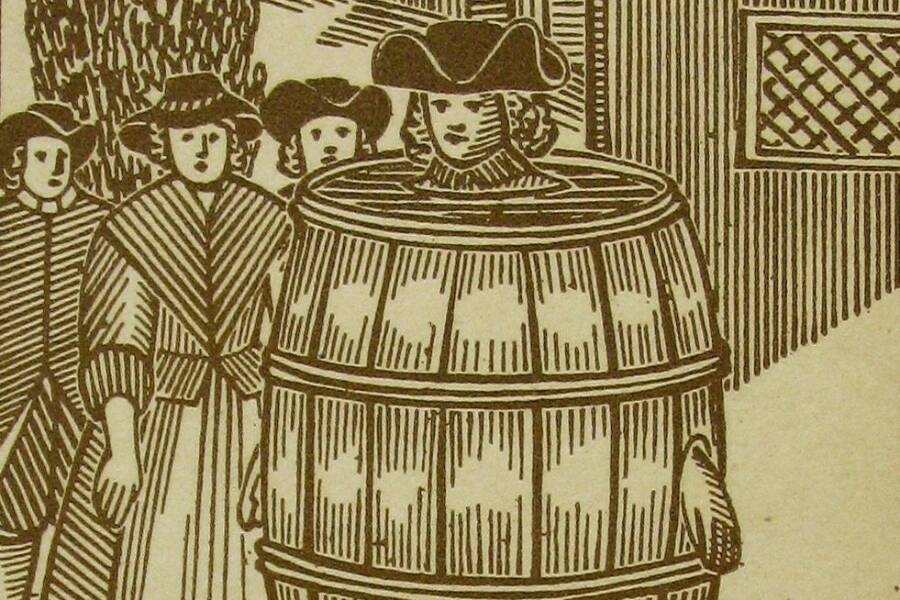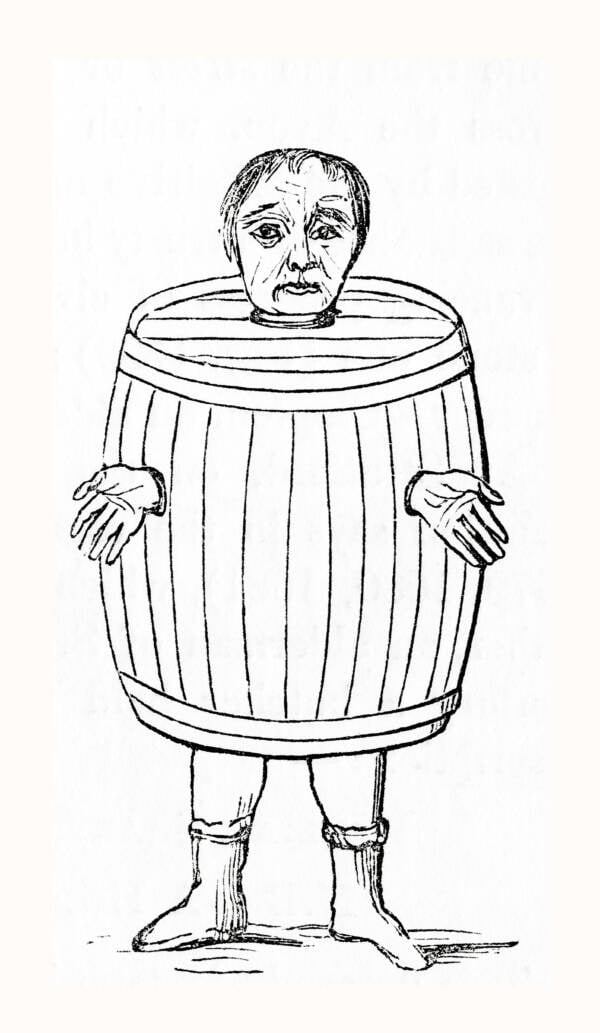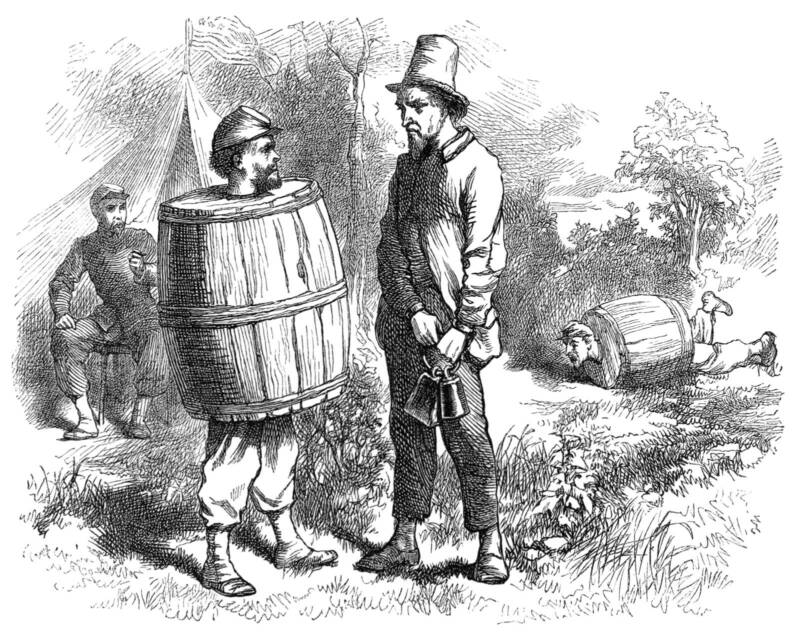Originating in 16th-century England, the Drunkard's Cloak was a public punishment for drunkenness that involved putting an empty barrel over the guilty party's torso, with holes cut out for their head and arms, and parading them through town to shame them.

Public DomainThe Drunkard’s Cloak began as a form of punishment in England, but quickly spread across Europe and to America.
If you’ve ever had the misfortune of waking up with a splitting headache, an upset stomach, extreme nausea, and perhaps a headful of regrets after a night of drinking, then congratulations — you’ve experienced a hangover. Most people might consider that punishment enough for overindulging, but not the people of 16th-century England. No, they devised another punishment for repeat offenders: the Drunkard’s Cloak.
This form of punishment was quite simple. Anyone found guilty of multiple drunken offenses had to wear an empty beer barrel with a hole at the top for their head and two holes on the sides for their arms (if they were lucky). They would then be paraded through town and shamed by their neighbors.
Drinking culture had always been a part of England’s history, but the Drunkard’s Cloak marked a firm pushback against this intrinsic cultural custom — and it was a punishment tailored to fit the crime.
The Importance Of Drinking Culture In Northeastern England
The Drunkard’s Cloak also goes by another name — the “Newcastle Cloak” — because some historians suspect that it was first used to punish drunkards in Newcastle upon Tyne in northeast England.
“Information on this device is sketchy and, while we are sure it was used in various towns and cities all over Europe, we don’t know where it was first thought of,” tour guide Alex Lyon of the Clink Prison Museum in London told Newcastle World. “While the only record of its use in England is from Newcastle upon Tyne in the Puritan 1650s, we don’t suggest that it was invented there – not to say that we doubt that it might have been.”
Why Newcastle? As historian Dan Jackson told HistoryExtra, the city has a bit of a reputation when it comes to drinking.

Universal History Archive/Universal Images Group via Getty ImagesA depiction of Newcastle in the 16th century.
“It’s a bit of a cliché, but [drinking culture] is very deep-seated,” Jackson explained. “Newcastle claims to be one of the first towns in England to brew beer, for example. And ‘Newcastle hospitality’ was a well-known phrase in the 18th century — this meant, essentially, to kill someone with kindness (a.k.a. take them out for a big drinking session).”
The truth is, people in Newcastle turned to alcohol hundreds of years ago for many of the same reasons as people today: they needed to unwind after a long, hard day’s work. Of course, at this particular juncture in time, that long day’s work consisted of toiling away in the coal mines and shipyards rather than sitting in an office for eight hours.
“It was inevitable [that drinking] would happen when people had time off from this stressful work,” Jackson said. “Coal miners were known for this certainly — and shipyard workers. Particularly seamen, who may have been away for months and arrived back home with money in their pocket.”
Naturally, when a large number of stressed-out people begin drinking heavily, there are bound to be a few (or more) who indulge a bit too heavily. And before long, the powers that be tried to combat this heavy drinking.
Parliament Tried To Crack Down On Drinking — And The Drunkard’s Cloak Was Born
Fearing the negative side effects of unimpeded drunken revelry, Parliament started searching for ways to regulate alcohol consumption across England. The first step in doing so was to pass the Ale Houses Act of 1551, which officially made drunkenness a civil offense.
What’s more, Parliament also implemented a number of strict statutes to punish “drunkards” — especially if they were arrested more than once.

Universal History Archive/Universal Images Group via Getty ImagesA depiction of a man wearing the Drunkard’s Cloak, a form of pillory that originated in England.
As VinePair reports, anyone arrested for drunkenness had to pay a small fine of five shillings. But additional arrests for public intoxication led to a more severe and humiliating punishment: the Drunkard’s Cloak.
The “cloak” was actually an open-ended beer keg with a hole for someone’s head. Sometimes — but not always — it also included holes for the drunkard’s arms. And according to Big Book of Pain: Torture & Punishment Through History by Mark P. Donnelly and Daniel Diehl, the idea for the Drunkard’s Cloak may have originated with King James I of England.
Apparently, the king relished thinking up punishments that were “bizarrely tailored to suit the particular crime.”
The Drunkard’s Cloak became more popular, however, under the rule of Oliver Cromwell, the English soldier and politician who served as Lord High Protector of England, Scotland, and Ireland from 1653 to 1658. According to Ancient Origins, Cromwell disliked, games, dancing, and especially drinking.
Though bizarre, use of the Drunkard’s Cloak quickly spread beyond England. In Germany, it was known as the Schandmantel, the “coat of shame”; in Denmark, the form of punishment was called the “Spanish Mantle.”
And of course, it soon found its way across the sea and to America.
Use Of The ‘Barrel-Shirt’ In The United States

Wikimedia CommonsThe “barrel-shirt,” the American version of the Drunkard’s Cloak.
Though the Drunkard’s Cloak originated in Europe, it made its way to the United States by the 19th century. According to Curious Punishments of Bygone Days by Alice Morse Earle, it was used on occasion to punish soldiers during the Civil War.
“One wretched delinquent was gratuitously framed in oak, his head being thrust through a hole cut in one end of the barrel,” reads one account gathered by Earle, “and the poor fellow loafed about in the most disconsolate manner, looking for all the world like a half-hatched chicken.”
Earle found other instances of the Drunkard’s Cloak as well, including in 1863 when a Maine volunteer infantry lieutenant punished two members of his company who had gotten drunk by putting them in barrels with only one hole cut out for their heads. He made them march through town with a placard that read, “I am wearing this for getting drunk” for four hours.
“I don’t believe they will get drunk again very soon,” the lieutenant said.
One officer even claimed that one of his men thanked him years after being put in the so-called barrel-shirt, saying that after the punishment he never had a drop of liquor again in his life.
Civil War soldiers might also be forced to don the Drunkard’s Cloak for stealing. Earle found instances of that as well, where men had to wear both a barrel and a placard saying something like: “I am a thief.”
Perhaps the most fascinating thing about the Drunkard’s Cloak, though, is simply how effective it was, despite being relatively tame. Compared to other methods of punishment or torture, the Drunkard’s Cloak was humane, relying more on the power of public scrutiny than physical pain. And often it was effective in changing someone’s behavior.
But not always. The Drunkard’s Cloak may have fallen out of fashion, but drinking continues to be a popular pastime in places like Newcastle.
“Alcohol has always been an important part of Northumbrian culture – for better or worse,” historian Dan Jackson explained. “But it’s always been a social lubricant of sorts, and Newcastle is still voted a party city today. It goes back centuries; it’s hard to shake off that culture.”
Curious about other strange forms of punishment from the past? Learn all about the terrifying, brutal truth of being hanged, drawn, and quartered. Or, check out the gruesome cut-by-cut torture method known as Lingchi.





